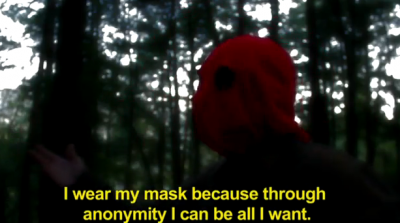By: debbie lynn elias
Makinov is a master of manipulation. A Belarussian cinematographer making his directorial feature debut with COME OUT AND PLAY, a reimagination of the 1976 chiller, Who Can Kill A Child, to protect his anonymity, even from his actors, Makinov is always shrouded in a red hood/scarf. No one has seen him or knows who he is. Thanks to a series of viral videos, Makinov has shed some light on his views of the world and his creative process of filmmaking. The “manifestos” are fascinating.
Issuing a Director’s Statement on COME OUT AND PLAY, Makinov avows: “I have no interest in promoting myself. That is why I wear this thing on my head. I do want to talk about my ideas. For a time now I have been torn and disgusted of seeing stupid modern life. We grow confused at what really matters. We must remember we are made of blood. An old proverb says that it is better to murder during time of plague. I would say the same when we talk about cinema.”
His very aura cloaked in mystery thanks to his red shroud, his manifestos and COME OUT AND PLAY, like with his film, Makinov himself makes me want to know more, more about him and the film. In this exclusive,unrestricted one-on-one interview conducted via email, Makinov talks about COME OUT AND PLAY and the power of red.

You are masterful at manipulation with COME OUT AND PLAY. It is impossible to look away from the screen as the story, minimal dialogue, yet effective building of tension draws the viewer into the story. I understand the film is based on the novel by Juan Jose Plans for which there was already the 1976 Spanish film, Who Can Kill A Child, made. What was your attraction to the novel and/or the 1976 film?
The novel had a very interesting core concept of children turning against the adults. It had some problems inherent of it’s literary form, but for a film the main idea worked as a great premise and I took that to make the script for the film.
How did you go about writing your screenplay adaptation?
I looked at the screenplay format and tried to emulate it using the book as the source. What ended up happening for various reasons is that we didn’t even use a screenplay, the actors didn’t know what was gonna happen after, neither some of the crew members. That helped to create the immediateness and rawness that is on the film.
Where there any particular challenges in writing the adaptation, additions, deletions, etc., from the novel and to distinguish your film from Who Can Kill A Child?
Juan Jose Plans’ book is concerned with exposing the adults as sinners and goes a bit over the top justifying everything that happens. With film you don’t need to explain, things are happening in real time and the audience, if the film is good, takes everything as it comes. So the film had to be very simple and minimal, no explanations, this thing is happening and that was it.
Essentially a “one-man band” as writer/director/editor/cinematographer, was this your intent from the conception of the script?
I didn’t think I was gonna get any help doing this so I conceived it from the beginning as a one man show. I also did the music.
Knowing this would be more or less your one-man show, when writing the script, were you thinking of and/or working on your visuals concurrently?
The visuals always come first. The way I worked before was me, the camera and the subject, so the visuals were the immediate result and the main concern. With this film I had to adapt my methods, but what interests me the most is the visual part.
You have great contrast in the visual tone and color palette of COME OUT AND PLAY. Wonderful compelling juxtaposition of color. What were your considerations in designing the visual palette of COME OUT AND PLAY?
The location gave us the clear blue hues of the sea and the white sand, and also the very dark nights that you see in the film. I wanted white and brightness in general to function as an element of horror, something that is seldom used, but I think there’s an elusive quality in white that when associated with something horrific makes it even more effective than the color of blood or the darkness of the night.
What led you to cast Vinessa Shaw and Ebon Moss-Bachrach as Beth and Francis, respectively?
The main actors came as a recommendation from Pablo. I’ve never met them before, but after talking to them I knew they could portray the characters that I needed for the film to work.
The location is beautiful. Where did you shoot this film?
The Holbox Island in the state of Quintana Roo, Mexico.
How long was your shoot and then subsequently, your post-production process?
Shoot was three weeks, post was for six months.
What format did you use for shooting? Digital? Film? And given the beautiful look of the film, what types of lenses were used?
Digital. Ultra prime lenses, 20mm to 80mm, mostly a 50mm and a zoom for just one shot I think.

Red is an important color to you. Be it with punctuated color in your film, or your own red-scarved face while shooting. What speaks to you about the color of “red”?
Red is the color of blood and also of the soul.
What is the greatest gift that filmmaking gives to you?
I try not to take from filmmaking as it goes a against the nature of film, a monster that only takes.
What did you personally take away from, or learn about yourself, in the making of this film?
I prefer to keep that for myself.
#












